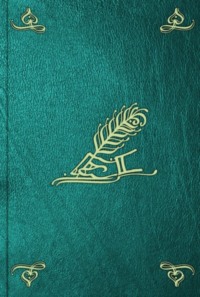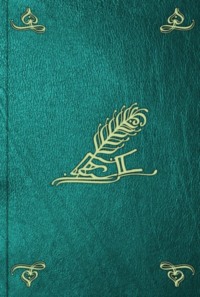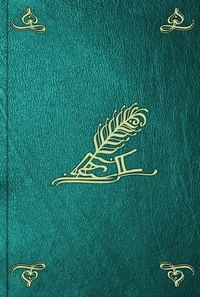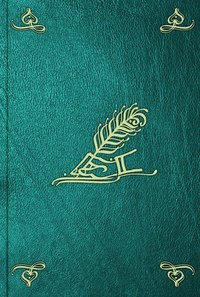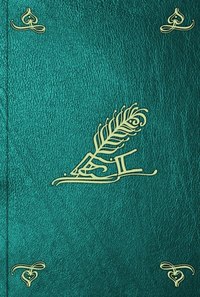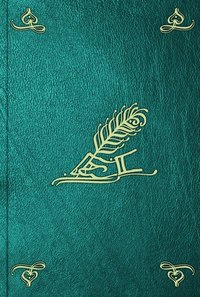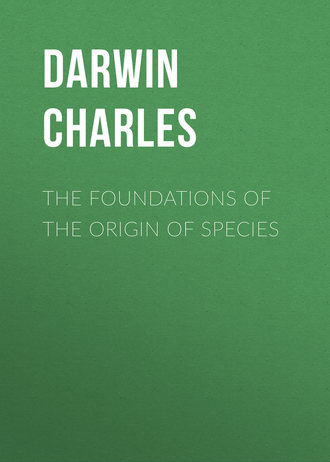 полная версия
полная версияThe Foundations of the Origin of Species
Be it remembered no naturalist pretends to give test from external characters of species; in many genera the distinction is quite arbitrary177. But there remains one other way of comparing species with races; it is to compare the effects of crossing them. Would it not be wonderful, if the union of two organisms, produced by two separate acts of Creation, blended their characters together when crossed according to the same rules, as two races which have undoubtedly descended from same parent stock; yet this can be shown to be the case. For sterility, though a usual «?», is not an invariable concomitant, it varies much in degree and has been shown to be probably dependent on causes closely analogous with those which make domesticated organisms sterile. Independent of sterility there is no difference between mongrels and hybrids, as can be shown in a long series of facts. It is strikingly seen in cases of instincts, when the minds of the two species or races become blended together178. In both cases if the half-breed be crossed with either parent for a few generations, all traces of the one parent form is lost (as Kölreuter in two tobacco species almost sterile together), so that the Creationist in the case of a species, must believe that one act of creation is absorbed into another!
Such are my reasons for believing that specific forms are not immutable. The affinity of different groups, the unity of types of structure, the representative forms through which fœtus passes, the metamorphosis of organs, the abortion of others cease to be metaphorical expressions and become intelligible facts. We no longer look «an» on animal as a savage does at a ship179, or other great work of art, as a thing wholly beyond comprehension, but we feel far more interest in examining it. How interesting is every instinct, when we speculate on their origin as an hereditary or congenital habit or produced by the selection of individuals differing slightly from their parents. We must look at every complicated mechanism and instinct, as the summary of a long history, «as the summing up» of180 useful contrivances, much like a work of art. How interesting does the distribution of all animals become, as throwing light on ancient geography. [We see some seas bridged over.] Geology loses in its glory from the imperfection of its archives181, but how does it gain in the immensity of the periods of its formations and of the gaps separating these formations. There is much grandeur in looking at the existing animals either as the lineal descendants of the forms buried under thousand feet of matter, or as the coheirs of some still more ancient ancestor. It accords with what we know of the law impressed on matter by the Creator, that the creation and extinction of forms, like the birth and death of individuals should be the effect of secondary [laws] means182. It is derogatory that the Creator of countless systems of worlds should have created each of the myriads of creeping parasites and [slimy] worms which have swarmed each day of life on land and water «on» [this] one globe. We cease being astonished, however much we may deplore, that a group of animals should have been directly created to lay their eggs in bowels and flesh of other, – that some organisms should delight in cruelty, – that animals should be led away by false instincts, – that annually there should be an incalculable waste of eggs and pollen. From death, famine, rapine, and the concealed war of nature we can see that the highest good, which we can conceive, the creation of the higher animals has directly come. Doubtless it at first transcends our humble powers, to conceive laws capable of creating individual organisms, each characterised by the most exquisite workmanship and widely-extended adaptations. It accords better with [our modesty] the lowness of our faculties to suppose each must require the fiat of a creator, but in the same proportion the existence of such laws should exalt our notion of the power of the omniscient Creator183. There is a simple grandeur in the view of life with its powers of growth, assimilation and reproduction, being originally breathed into matter under one or a few forms, and that whilst this our planet has gone circling on according to fixed laws, and land and water, in a cycle of change, have gone on replacing each other, that from so simple an origin, through the process of gradual selection of infinitesimal changes, endless forms most beautiful and most wonderful have been evolved184.
N.B. – There ought somewhere to be a discussion from Lyell to show that external conditions do vary, or a note to Lyell's works «work?».
Besides other difficulties in ii. Part, non-acclimatisation of plants. Difficulty when asked how did white and negro become altered from common intermediate stock: no facts. We do NOT know that species are immutable, on the contrary. What arguments against this theory, except our not perceiving every step, like the erosion of valleys185.
THE ESSAY OF 1844
PART I
CHAPTER I
ON THE VARIATION OF ORGANIC BEINGS UNDER DOMESTICATION; AND ON THE PRINCIPLES OF SELECTION
The most favourable conditions for variation seem to be when organic beings are bred for many generations under domestication186: one may infer this from the simple fact of the vast number of races and breeds of almost every plant and animal, which has long been domesticated. Under certain conditions organic beings even during their individual lives become slightly altered from their usual form, size, or other characters: and many of the peculiarities thus acquired are transmitted to their offspring. Thus in animals, the size and vigour of body, fatness, period of maturity, habits of body or consensual movements, habits of mind and temper, are modified or acquired during the life of the individual187, and become inherited. There is reason to believe that when long exercise has given to certain muscles great development, or disuse has lessened them, that such development is also inherited. Food and climate will occasionally produce changes in the colour and texture of the external coverings of animals; and certain unknown conditions affect the horns of cattle in parts of Abyssinia; but whether these peculiarities, thus acquired during individual lives, have been inherited, I do not know. It appears certain that malconformation and lameness in horses, produced by too much work on hard roads, – that affections of the eyes in this animal probably caused by bad ventilation, – that tendencies towards many diseases in man, such as gout, caused by the course of life and ultimately producing changes of structure, and that many other diseases produced by unknown agencies, such as goitre, and the idiotcy resulting from it, all become hereditary.
It is very doubtful whether the flowers and leaf-buds, annually produced from the same bulb, root, or tree, can properly be considered as parts of the same individual, though in some respects they certainly seem to be so. If they are parts of an individual, plants also are subject to considerable changes during their individual lives. Most florist-flowers if neglected degenerate, that is, they lose some of their characters; so common is this, that trueness is often stated, as greatly enhancing the value of a variety188: tulips break their colours only after some years’ culture; some plants become double and others single, by neglect or care: these characters can be transmitted by cuttings or grafts, and in some cases by true or seminal propagation. Occasionally a single bud on a plant assumes at once a new and widely different character: thus it is certain that nectarines have been produced on peach trees and moss roses on provence roses; white currants on red currant bushes; flowers of a different colour from that of the stock, in Chrysanthemums, Dahlias, sweet-williams, Azaleas, &c., &c.; variegated leaf-buds on many trees, and other similar cases. These new characters appearing in single buds, can, like those lesser changes affecting the whole plant, be multiplied not only by cuttings and such means, but often likewise by true seminal generation.
The changes thus appearing during the lives of individual animals and plants are extremely rare compared with those which are congenital or which appear soon after birth. Slight differences thus arising are infinitely numerous: the proportions and form of every part of the frame, inside and outside, appear to vary in very slight degrees: anatomists dispute what is the “beau ideal” of the bones, the liver and kidneys, like painters do of the proportions of the face: the proverbial expression that no two animals or plants are born absolutely alike, is much truer when applied to those under domestication, than to those in a state of nature189. Besides these slight differences, single individuals are occasionally born considerably unlike in certain parts or in their whole structure to their parents: these are called by horticulturists and breeders “sports”; and are not uncommon except when very strongly marked. Such sports are known in some cases to have been parents of some of our domestic races; and such probably have been the parents of many other races, especially of those which in some senses may be called hereditary monsters; for instance where there is an additional limb, or where all the limbs are stunted (as in the Ancon sheep), or where a part is wanting, as in rumpless fowls and tailless dogs or cats190. The effects of external conditions on the size, colour and form, which can rarely and obscurely be detected during one individual life, become apparent after several generations: the slight differences, often hardly describable, which characterize the stock of different countries, and even of districts in the same country, seem to be due to such continued action.
On the hereditary tendency
A volume might be filled with facts showing what a strong tendency there is to inheritance, in almost every case of the most trifling, as well as of the most remarkable congenital peculiarities191. The term congenital peculiarity, I may remark, is a loose expression and can only mean a peculiarity apparent when the part affected is nearly or fully developed: in the Second Part, I shall have to discuss at what period of the embryonic life connatal peculiarities probably first appear; and I shall then be able to show from some evidence, that at whatever period of life a new peculiarity first appears, it tends hereditarily to appear at a corresponding period192. Numerous though slight changes, slowly supervening in animals during mature life (often, though by no means always, taking the form of disease), are, as stated in the first paragraphs, very often hereditary. In plants, again, the buds which assume a different character from their stock likewise tend to transmit their new peculiarities. There is not sufficient reason to believe that either mutilations193 or changes of form produced by mechanical pressure, even if continued for hundreds of generations, or that any changes of structure quickly produced by disease, are inherited; it would appear as if the tissue of the part affected must slowly and freely grow into the new form, in order to be inheritable. There is a very great difference in the hereditary tendency of different peculiarities, and of the same peculiarity, in different individuals and species; thus twenty thousand seeds of the weeping ash have been sown and not one come up true; – out of seventeen seeds of the weeping yew, nearly all came up true. The ill-formed and almost monstrous “Niata” cattle of S. America and Ancon sheep, both when bred together and when crossed with other breeds, seem to transmit their peculiarities to their offspring as truly as the ordinary breeds. I can throw no light on these differences in the power of hereditary transmission. Breeders believe, and apparently with good cause, that a peculiarity generally becomes more firmly implanted after having passed through several generations; that is if one offspring out of twenty inherits a peculiarity from its parents, then its descendants will tend to transmit this peculiarity to a larger proportion than one in twenty; and so on in succeeding generations. I have said nothing about mental peculiarities being inheritable for I reserve this subject for a separate chapter.
Causes of Variation
Attention must here be drawn to an important distinction in the first origin or appearance of varieties: when we see an animal highly kept producing offspring with an hereditary tendency to early maturity and fatness; when we see the wild-duck and Australian dog always becoming, when bred for one or a few generations in confinement, mottled in their colours; when we see people living in certain districts or circumstances becoming subject to an hereditary taint to certain organic diseases, as consumption or plica polonica, – we naturally attribute such changes to the direct effect of known or unknown agencies acting for one or more generations on the parents. It is probable that a multitude of peculiarities may be thus directly caused by unknown external agencies. But in breeds, characterized by an extra limb or claw, as in certain fowls and dogs; by an extra joint in the vertebræ; by the loss of a part, as the tail; by the substitution of a tuft of feathers for a comb in certain poultry; and in a multitude of other cases, we can hardly attribute these peculiarities directly to external influences, but indirectly to the laws of embryonic growth and of reproduction. When we see a multitude of varieties (as has often been the case, where a cross has been carefully guarded against) produced from seeds matured in the very same capsule194, with the male and female principle nourished from the same roots and necessarily exposed to the same external influences; we cannot believe that the endless slight differences between seedling varieties thus produced, can be the effect of any corresponding difference in their exposure. We are led (as Müller has remarked) to the same conclusion, when we see in the same litter, produced by the same act of conception, animals considerably different.
As variation to the degree here alluded to has been observed only in organic beings under domestication, and in plants amongst those most highly and long cultivated, we must attribute, in such cases, the varieties (although the difference between each variety cannot possibly be attributed to any corresponding difference of exposure in the parents) to the indirect effects of domestication on the action of the reproductive system195. It would appear as if the reproductive powers failed in their ordinary function of producing new organic beings closely like their parents; and as if the entire organization of the embryo, under domestication, became in a slight degree plastic196. We shall hereafter have occasion to show, that in organic beings, a considerable change from the natural conditions of life, affects, independently of their general state of health, in another and remarkable manner the reproductive system. I may add, judging from the vast number of new varieties of plants which have been produced in the same districts and under nearly the same routine of culture, that probably the indirect effects of domestication in making the organization plastic, is a much more efficient source of variation than any direct effect which external causes may have on the colour, texture, or form of each part. In the few instances in which, as in the Dahlia197, the course of variation has been recorded, it appears that domestication produces little effect for several generations in rendering the organization plastic; but afterwards, as if by an accumulated effect, the original character of the species suddenly gives way or breaks.
On Selection
We have hitherto only referred to the first appearance in individuals of new peculiarities; but to make a race or breed, something more is generally198 requisite than such peculiarities (except in the case of the peculiarities being the direct effect of constantly surrounding conditions) should be inheritable, – namely the principle of selection, implying separation. Even in the rare instances of sports, with the hereditary tendency very strongly implanted, crossing must be prevented with other breeds, or if not prevented the best characterized of the half-bred offspring must be carefully selected. Where the external conditions are constantly tending to give some character, a race possessing this character will be formed with far greater ease by selecting and breeding together the individuals most affected. In the case of the endless slight variations produced by the indirect effects of domestication on the action of the reproductive system, selection is indispensable to form races; and when carefully applied, wonderfully numerous and diverse races can be formed. Selection, though so simple in theory, is and has been important to a degree which can hardly be overrated. It requires extreme skill, the results of long practice, in detecting the slightest difference in the forms of animals, and it implies some distinct object in view; with these requisites and patience, the breeder has simply to watch for every the smallest approach to the desired end, to select such individuals and pair them with the most suitable forms, and so continue with succeeding generations. In most cases careful selection and the prevention of accidental crosses will be necessary for several generations, for in new breeds there is a strong tendency to vary and especially to revert to ancestral forms: but in every succeeding generation less care will be requisite for the breed will become truer; until ultimately only an occasional individual will require to be separated or destroyed. Horticulturalists in raising seeds regularly practise this, and call it “roguing,” or destroying the “rogues” or false varieties. There is another and less efficient means of selection amongst animals: namely repeatedly procuring males with some desirable qualities, and allowing them and their offspring to breed freely together; and this in the course of time will affect the whole lot. These principles of selection have been methodically followed for scarcely a century; but their high importance is shown by the practical results, and is admitted in the writings of the most celebrated agriculturalists and horticulturalists; – I need only name Anderson, Marshall, Bakewell, Coke, Western, Sebright and Knight.
Even in well-established breeds the individuals of which to an unpractised eye would appear absolutely similar, which would give, it might have been thought, no scope to selection, the whole appearance of the animal has been changed in a few years (as in the case of Lord Western’s sheep), so that practised agriculturalists could scarcely credit that a change had not been effected by a cross with other breeds. Breeders both of plants and animals frequently give their means of selection greater scope, by crossing different breeds and selecting the offspring; but we shall have to recur to this subject again.
The external conditions will doubtless influence and modify the results of the most careful selection; it has been found impossible to prevent certain breeds of cattle from degenerating on mountain pastures; it would probably be impossible to keep the plumage of the wild-duck in the domesticated race; in certain soils, no care has been sufficient to raise cauliflower seed true to its character; and so in many other cases. But with patience it is wonderful what man has effected. He has selected and therefore in one sense made one breed of horses to race and another to pull; he has made sheep with fleeces good for carpets and other sheep good for broadcloth; he has, in the same sense, made one dog to find game and give him notice when found, and another dog to fetch him the game when killed; he has made by selection the fat to lie mixed with the meat in one breed and in another to accumulate in the bowels for the tallow-chandler199; he has made the legs of one breed of pigeons long, and the beak of another so short, that it can hardly feed itself; he has previously determined how the feathers on a bird’s body shall be coloured, and how the petals of many flowers shall be streaked or fringed, and has given prizes for complete success; – by selection, he has made the leaves of one variety and the flower-buds of another variety of the cabbage good to eat, at different seasons of the year; and thus has he acted on endless varieties. I do not wish to affirm that the long-and short-wooled sheep, or that the pointer and retriever, or that the cabbage and cauliflower have certainly descended from one and the same aboriginal wild stock; if they have not so descended, though it lessens what man has effected, a large result must be left unquestioned.
In saying as I have done that man makes a breed, let it not be confounded with saying that man makes the individuals, which are given by nature with certain desirable qualities; man only adds together and makes a permanent gift of nature’s bounties. In several cases, indeed, for instance in the “Ancon” sheep, valuable from not getting over fences, and in the turnspit dog, man has probably only prevented crossing; but in many cases we positively know that he has gone on selecting, and taking advantage of successive small variations.
Selection200 has been methodically followed, as I have said, for barely a century; but it cannot be doubted that occasionally it has been practised from the remotest ages, in those animals completely under the dominion of man. In the earliest chapters of the Bible there are rules given for influencing the colours of breeds, and black and white sheep are spoken of as separated. In the time of Pliny the barbarians of Europe and Asia endeavoured by cross-breeding with a wild stock to improve the races of their dogs and horses. The savages of Guyana now do so with their dogs: such care shows at least that the characters of individual animals were attended to. In the rudest times of English history, there were laws to prevent the exportation of fine animals of established breeds, and in the case of horses, in Henry VIII’s time, laws for the destruction of all horses under a certain size. In one of the oldest numbers of the Phil. Transactions, there are rules for selecting and improving the breeds of sheep. Sir H. Bunbury, in 1660, has given rules for selecting the finest seedling plants, with as much precision as the best recent horticulturalist could. Even in the most savage and rude nations, in the wars and famines which so frequently occur, the most useful of their animals would be preserved: the value set upon animals by savages is shown by the inhabitants of Tierra del Fuego devouring their old women before their dogs, which as they asserted are useful in otter-hunting201: who can doubt but that in every case of famine and war, the best otter-hunters would be preserved, and therefore in fact selected for breeding. As the offspring so obviously take after their parents, and as we have seen that savages take pains in crossing their dogs and horses with wild stocks, we may even conclude as probable that they would sometimes pair the most useful of their animals and keep their offspring separate. As different races of men require and admire different qualities in their domesticated animals, each would thus slowly, though unconsciously, be selecting a different breed. As Pallas has remarked, who can doubt but that the ancient Russian would esteem and endeavour to preserve those sheep in his flocks which had the thickest coats. This kind of insensible selection by which new breeds are not selected and kept separate, but a peculiar character is slowly given to the whole mass of the breed, by often saving the life of animals with certain characteristics, we may feel nearly sure, from what we see has been done by the more direct method of separate selection within the last 50 years in England, would in the course of some thousand years produce a marked effect.
Crossing Breeds
When once two or more races are formed, or if more than one race, or species fertile inter se, originally existed in a wild state, their crossing becomes a most copious source of new races202. When two well-marked races are crossed the offspring in the first generation take more or less after either parent or are quite intermediate between them, or rarely assume characters in some degree new. In the second and several succeeding generations, the offspring are generally found to vary exceedingly, one compared with another, and many revert nearly to their ancestral forms. This greater variability in succeeding generations seems analogous to the breaking or variability of organic beings after having been bred for some generations under domestication203. So marked is this variability in cross-bred descendants, that Pallas and some other naturalists have supposed that all variation is due to an original cross; but I conceive that the history of the potato, Dahlia, Scotch Rose, the guinea-pig, and of many trees in this country, where only one species of the genus exists, clearly shows that a species may vary where there can have been no crossing. Owing to this variability and tendency to reversion in cross-bred beings, much careful selection is requisite to make intermediate or new permanent races: nevertheless crossing has been a most powerful engine, especially with plants, where means of propagation exist by which the cross-bred varieties can be secured without incurring the risk of fresh variation from seminal propagation: with animals the most skilful agriculturalists now greatly prefer careful selection from a well-established breed, rather than from uncertain cross-bred stocks.



